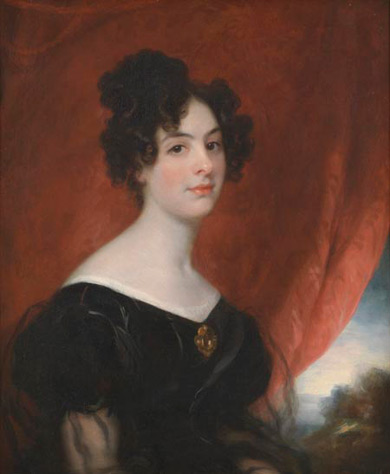Ellen Stirling
Phillips demonstrates his broad technical skills by combining a range of difficult elements: the face; the figure; drapery; and landscape. As a commissioned portrait painter, it was important for the artist to promote his talents among the wealthy in order to attract new business.
Stirling’s extravagant gown, with its open neckline and short puffed sleeves, accurately reflects the fashion of the 1820s. From what we know of this period we can also assume she is wearing a tight-laced corset, though she expresses no sign of discomfort.
How does the artist use dress to represent Stirling’s social status and wealth?
The artist reveals clues about Stirling’s character and aspirations through her expression and pose.
What words would you use to describe Stirling’s expression?
What do her pose and expression tell you about her character?
The artist choreographs the portrait like a stage performance, using the heavy curtain behind Stirling as a theatrical device to draw attention to the landscape in the distance.
What is the significance of the landscape in Phillips’ portrait?
How does the artist use background and setting tell us about Stirling’s history and identity?
This portrait marks the movement of a gentleman’s wife to a loftier place on the social ladder. It is a portrait which matches the function she fulfilled as the focus of social attention in the new settlement.
Read more about the portrait in Duty Bound, Portrait 30.
Move your mouse over the portrait to
see the points of interest.
About the artist
Thomas Phillips was born in Warwickshire, England in 1770. At the age of 20, he moved to London where he worked as a glass painter before training as an artist at the Royal Academy.
In 1804, Phillips was elected as an associate to the Royal Academy and from 1825-1832 held the position of Professor of Painting.
A prolific portrait artist, Phillips painted over 700 portraits during his career. His book of sitters reveals that he painted Ellen and other members of her family around the time of her departure for WA in January 1829.
See the portrait of Sir Joseph Banks by Thomas Phillips in the National Portrait Gallery collection.


